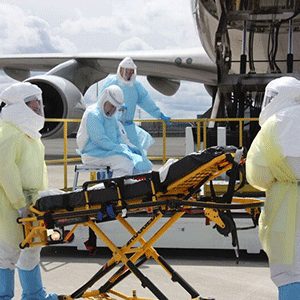
JOINT NEWS RELEASE: Super-Sized Medevac Plane Lands in Spokane, Community Practices its Response to Infectious Disease Threats
SPOKANE, Wash. – April 11, 2018 – Today, local health and response partners achieved another milestone in their collaboration and readiness to meet the demands of emerging infectious disease threats like Ebola, coronaviruses and others.
As part of a federal exercise named Tranquil Terminus, two Americans hypothetically confirmed to have Ebola were safely moved from St. Luke’s hospital in Boise to Spokane’s Providence Sacred Heart Medical Center and Children’s Hospital (Sacred Heart).
“We know that patients arriving with infectious diseases is a real possibility in many communities, including ours. We practice our preparedness and safety so we can care for these patients more prudently, which will also help protect caregivers and community,” said Dr. Bob Lutz, Spokane Regional Health District health officer. “The idea is to be ready.”
Today’s larger national exercise included seven mock patients, four initially arriving at Spokane International Airport (SIA) on a Boeing 747 cargo jet. Two “patients” were transported to Sacred Heart’s Special Pathogens Unit (SPU)—one of only 10 regional units in the U.S. The other two patients were flown to Cedars-Sinai Medical Center in Los Angeles. The converted plane—one of the largest types to land at SIA—holds two specialized biocontainment units, each the size of a 44-foot shipping container. The units are designed to handle patients with any type of infectious disease. The plane is one of the federal government’s most powerful tools in combating infectious disease threats.
American Medical Response transported the patients to Sacred Heart separately, practicing infection control procedures for a critical “patient,” who was more contagious, verses one whose disease progressed more slowly. It was a key opportunity for responders to exercise using their personal protective equipment, as well as practice how to effectively clean vehicles and equipment after transport.
“This exercise was designed to test and validate procedures and capabilities to move highly infectious disease patients to pre-identified regional treatment centers,” said Christa Arguinchona, Sacred Heart Intensive Care Unit assistant nurse manager and SPU project coordinator. “What we saw here today is our community standing ready to care for those who are very sick, while also able to diligently prevent the spread of disease.”
In concert with patient offloading, 25 medical observers witnessed processes needed to move infectious patients and 45 individuals toured the unique aircraft. Observers and participants alike benefited from witnessing infection detection and control methods.
Continued Dr. Lutz, “Although significant progress has been made in detecting and understanding the viruses that cause hemorrhagic fevers, like Ebola, as well as other recently identified and emerging diseases like MERS and SARS, there is always more we can learn. People and viruses travel, and diseases emerge in new areas and act in unexpected ways. There is continued need to exercise preventative and control methods, rapid response, and active communication between responders and the greater community.”
The Assistant Secretary for Preparedness and Response (ASPR), under the U.S. Department of Health and Human Services (HHS), coordinated Tranquil Terminus. In addition to Sacred Heart, four other ASPR regional centers participated in the exercise. ASPR also coordinated with partners at the Department of State and state governments.
Other regional and Joint Information System participants not previously mentioned include City of Spokane, Greater Spokane Emergency Management, Spokane Fire Department, SIA’s Fire and Police departments, Spokane Police Department, Washington State Region 9 Healthcare Coalition, and Washington State Department of Health.
Behind-the-scenes B-roll and still photography of the full exercise is available to media and the community at srhd.org/tranquilfootage
###

